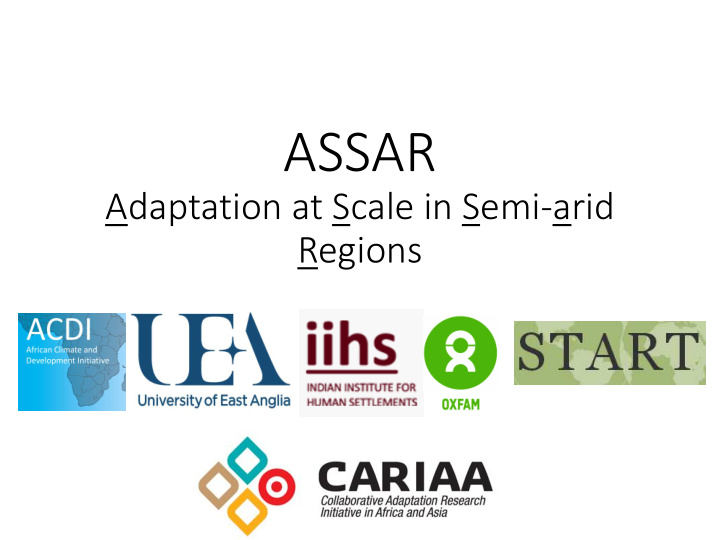



ASSAR Adaptation at Scale in Semi-arid Regions
Research problem and scope • Harsh climatic & non-climate stressors in SARs lead to high vulnerability • SARs are generally marginalized from political and economic development priorities • Usually only short-term response strategies to climate stresses addressed • Long-term climate projections in Africa & suggest necessity of far reaching adaptation actions • Large potential impacts on food production & security, water resources, from both heat and changes in moisture • Often many social, political, economic and governance barriers to adaptation. • Robust knowledge systems and capacity to respond are needed
Objectives • Generate new stakeholder-driven knowledge on vulnerability and adaptation to climate change in SARs • Focus on understanding what enables effective, long-term and sustainable adaptation • Develop and trial relevant and actionable strategies for adaptation • Innovative communication approaches for effective knowledge sharing on climate change vulnerability and adaptation in SARs • Capacity strengthening for adaptation in SARs, in research, policy and practice domains • ASSAR research is used well beyond CARIAA so as to shape policies and practices that enable widespread adaptation to climate change
ASSAR Research Questions • What are critical determinants and drivers that shape vulnerability of people in SARs? • Where are the knowledge and capacity gaps in accessing, contextualizing and acting on climate information? • What new approaches can be developed to lead to more effective shaping and communication of climate messages ? • What approaches have been/are being used in developing adaptation strategies , and how effective have they been? • How might climate change affect SARs , and what are the consequences for society? • How best can adaptation be planned in the face of biophysical and socio- economic uncertainties? • What are the barriers and enablers for effective, long-term adaptation , and what interventions/investments are required to enable more widespread, sustained adaptation?
Approach • Multi-scale : Regional -> National/State -> District/Local • Multi-site : Southern Africa, West Africa, East Africa, Asia • Multi-dimensional drivers of vulnerability and adaptation capacity: • Biophysical drivers • Social, political, economic and governance drivers • Research vehicle: Transformative Scenario Planning • Social learning process • Co-sensing/exploration of vulnerabilities, opportunities, barriers and enablers • Co-development of scenarios of key drivers/barriers • Co- development of adaptation strategies that “change the future”
Project phases
Assar Consortium Structure
Regional Foci
Consortium in context of related initiatives • CORDEX • ACCRA • BRACED • CCAFS • CLIMDEV • SASSCAL / WASCAL • India?
Forseen activities & role of each member ASSAR governance and functional structure
More recommend